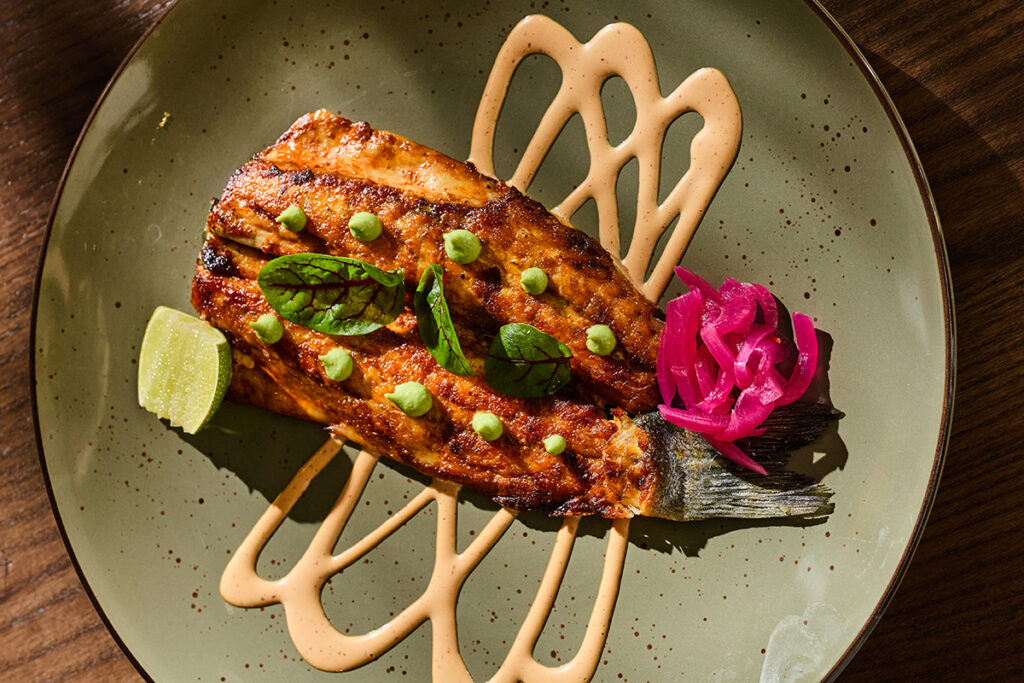Considering how historically undervalued Mexican food has been, T’ähä came onto the scene confidently and unapologetically—as it should. Flanked between the Plaza’s swanky Fontaine hotel and bougie Monarch Bar, T’ähä may have one of the priciest menus you’ve seen offering enchiladas, tacos and tamales. Again, as it should. Everything is made from scratch, from the moles to the hand-pressed, cooked-to-order tortillas.
Considering KCK just launched a tour bus to explore their lauded and nationally known Taco Trail, Kansas Citians aren’t exactly lacking great options for Mexican food. However, we are lacking regional Mexican cuisine—and certainly in the fine dining realm. T’ähä’s menu, full of ingredients like “huitlacoche” and “xoconostle” and priced at an average of $40 per entree, reads like a breath of fresh air and fills a gap in KC’s high-end restaurant scene. But high prices also mean high expectations, and while the restaurant is starting out on a strong note, dishes need to be fine-tuned to deliver the kind of customer satisfaction that will keep it in business for years to come.

Jose Gomez opened T’ähä alongside his father, Fidel Gomez. They’re no strangers to the restaurant world. Fidel opened and continues to own two Little Haciendas in Branson, the first of which has been open for over two decades. They’re more Tex Mex-style, but with T’ähä, which means “dream” in Otomi—the indigenous community Fidel’s mother is from—Fidel offers flavors closer to his roots in Hidalgo, Mexico. T’ähä’s menu is all him.
Considering the immense undertaking that opening an authentic and regional fine dining Mexican restaurant is, the Gomezs’ years of experience in the industry is immediately palpable. From the sophisticated environs and solid service to the bar program and women in the kitchen working masa into tortillas on the daily, the 172-seat operation (patio included) is running smoothly. They know their clientele and the neighborhood, and they cater to it well.

Having taken over the former Jax Fish House and Oyster Bar, Jose and Fidel kept the former layout, large bar included, but hired the local bcDESIGNGROUP to implement an interior that plays more to the likes of a contemporary restaurant in Mexico City, with various textures of wood and tile. The result is smart and stylish without trying too hard.
The menu is a clear labor of love. T’ähä sources organic natural heirloom corn from Wichita-based Pinole Blue and Las Marias, a Northeast tortilleria that creates masa using the traditional Mesoamerican method of nixtamalization. To get a taste of the beauty that is freshly pressed masa, order an empanada appetizer—it doesn’t matter which one. The soft crackle of the fried blue corn stuffed with cheese is decadent. The small, fluffy tortillas of the sopecitos de chorizo are comforting but give texture and depth beyond your usual Tex-Mex order.
Appetizers are kept comforting and err on upscale approachability. Ordering the app of beef meatballs containing hard boiled eggs, a traditional recipe from Central Mexico and one from Jose and Fidel’s childhood, isn’t necessary, but you will like it. The meatballs swim in a soupy, savory and bright cactus sauce that reads like a thin marinara. Through the appetizers, as well as a couple entrees, T’ähä takes the opportunity to feature a cornerstone of Mexican cuisine—seafood. The crudos and aguachiles are kept classic. Scallops and octopus are served delightfully fresh. On one visit, my dining companion and I happily dove into the branzino entree, although for $40 we would have liked to see the head kept on to add a bit of grandeur.
The entrees are where T’ähä invites you to see the full scope of Mexico’s culinary diversity. The signature dish of lamb barbacoa pays homage to the influx of Lebanese immigrants to Mexico in the early 1900s. Just as goat is traditionally used in birria tacos, lamb is traditionally used when cooking barbacoa. Fidel sits his lamb lollipops on a bed of hummus infused with peppers and lamb stock, giving tribute to Mexico’s Arabic influences.
The rabbit—grilled, baked and tossed with guajillo chilies—is served with a hefty schmear of guajillo sauce. It’s a dish reminiscent of Fidel’s childhood in Hidalgo, but pairing guajillo with guajillo left much to be desired beyond the few roasted vegetables that accompanied the plate. The half cornish hen smothered with mole was another fun and well-cooked protein dampened by not enough complexity. It was so hearty, it needed another flavorful element or two, something to tactfully play off the earthy, smokey mole and break up the monotonous richness of the dish.

You may have seen a chef or two on Netflix’s Chef’s Table, or some other cooking show, come damn near to tears when talking about Mexico’s beautiful, complex and soulful mole sauce. It is certainly something that should be held in high regard, and T’ähä aims to do it justice. Their red mole is Jose’s grandmother’s recipe and contains 24 ingredients. (Jose was able to indulge me in a few: dark chocolate, ancho chilies, peanuts, almonds, mulato chilies, plantains, fried tortillas, even toasted bread.) Over the enchiladas, it was beautiful. On the cornish hen, it was bitter. Jose says they’ve almost got a standardized recipe worked out.
When I ask Jose about T’ähä’s high prices, he says that, sure, his Plaza location adds to the cost, but his restaurant is also about breaking a glass ceiling. After all, no one blinks an eye when paying for upscale European restaurants.
“Why are Mexican cuisine, Mexican labor and Mexican products expected to be cheap and fast?” Jose asks. “Our team is doing so much labor with love and care for the culture. We’re hand-pressing all of our tortillas to order, using fresh, quality ingredients. The salsas are homemade, along with the 24-ingredient moles. We’re so proud of our tortilla ladies because that is not an easy job. It really is a from-scratch kitchen.”
T’ähä reminds me of the South JoCo fine dining Indian restaurant, Of Course, helmed by Swetha Newcomb. We dubbed Of Course one of KC’s Best New Restaurants last year, and Newcomb was similarly open with the struggles of offering Indian food, albeit with a Midwestern flair, in an elevated format. Diners are hit with confusion when they see Indian ingredients fused into gourmet plates and priced accordingly.

I see T’ähä’s vision, even if it didn’t always show up on the plate. I stopped by the Plaza restaurant last-minute on a Taco Tuesday to take advantage of the a la carte options. I ordered every single one. Unfortunately, none wowed, and in a city where great, affordable tacos are so accessible, that’s what they needed to do. I followed it up with the tamale served over a banana leaf and topped with a guajillo sauce. The pork was bland, the guajillo sauce salty and bitter.
T’ähä has only been open since late May. Like Of Course, it’s natural that finding its footing is going to take some time. It’s a new venture not only for Jose and Fidel but for KC, too. Plus, you most likely won’t be going to T’ähä for tacos. You’ll go there for the experience of being in a special environment and trying dishes and flavors you’ve never had before. I have hope that as more thoughtful components and technical precision are added along the way, T’ähä can offer the consistent wow factor it needs to deliver the authenticity and culture Kansas Citians crave.





